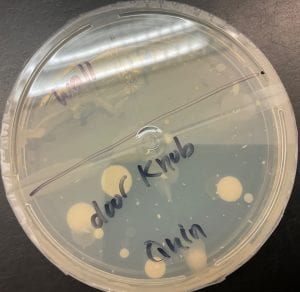Since the start of February, most of our classes have changed. For example, instead of maker, I now have science until the end of the year. In science, we just finished our first project, Small but mighty. For this project, we started by learning about cells and cellular organisms. I looked at many different things including dirty water, a dead moth’s wing, eraser shavings and more through microscopes and observed cells splitting and duplicating. Here are some pictures I took:
Water: (It’s way dirtier that I expected!)

Moth wing: (Woah! That’s a very cool pattern!)


Eraser shaving: (Looks like a… Cloud?)


Cell duplication: (The pink circle is 1 cell. The purple ones have both split, one into 2 pieces, and the other into 4 pieces.)

After that, I hypothesized that things we touch often will have more bacteria than things that rarely get touched, and I predicted that a doorknob would have more bacteria than a wall. I swabbed a doorknob and a wall and rubbed them on a substance called agar (A gelatinous substance used to grow bacteria.) in a Petri dish. I waited 7 days to compare the bacteria that had grown from the doorknob and the wall. The results? It turns out (Drum roll please)… I was right! There was more visible bacteria on the doorknob side than the wall side! The doorknob, however, didn’t grow nearly as much bacteria as I expected, or as much other people in my class who I used a doorknob. I think the reason for this is that I chose a doorknob that doesn’t get used as often as some others. here are the results:


Next we learnt about the immune system and it’s components. I made character cards for each type of cell (And antibody) in the adaptive immune system. I used Pokémon as a base for my drawings, and I made puns out of their names. For some Pokémon, I tweaked their appearances to suit their cell more, for example the white blood cell (White blood CELLebi) had to be white of course. For others, I made up descriptions that make sense based on the Pokémon’s appearance and the cells. My personal favourite is the T-CELLesteela, which also happens to be based on one of my favourite Pokémon, Celesteela.





We then learnt about vaccines, and how all four different types of vaccines work. An inactivated vaccine has a dead or inactivated virus that, when entered into the bloodstream, triggers the immune system just like how a activated virus would, giving the body a training session against that type of virus. A live attenuated vaccine works exactly the same as as inactivated vaccine, but the virus is weakened instead of killed. A subunit vaccine has small pieces of the virus, but they’re big enough to trigger the immune system, just like the previous two. mRNA Vaccines contain the DNA of the virus which, when injected, will be created by a ribosome inside of the cells, and that will trigger the immune system. I made a public health infographic with help from my friend Finn (Go check his blog out as well!) talking about a common reason why people might not want to get a vaccine.

To finish this project, I made a public health poster for kids. My poster will likely be put in a North Vancouver elementary school (sd44/nvsd). I used drawings done by students at Eastview Elementary (An elementary school in sd44).

Overall, I think this was a great way to start science, and I hope that the rest of the year will be just as good.